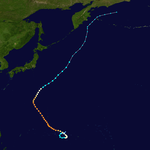1976 Pacific typhoon season
| 1976 Pacific typhoon season | |
|---|---|

Season summary map
|
|
| Seasonal boundaries | |
| First system formed | January 26, 1976 |
| Last system dissipated | December 30, 1976 |
| Strongest storm | |
| Name | Louise |
| • Maximum winds | 260 km/h (160 mph) (1-minute sustained) |
| • Lowest pressure | 895 hPa (mbar) |
| Seasonal statistics | |
| Total depressions | 30 |
| Total storms | 25 |
| Typhoons | 14 |
| Super typhoons | 4 |
| Total fatalities | Unknown |
| Total damage | Unknown |
| Related articles | |
| Category 1 typhoon (SSHWS) | |
| Duration | January 26 – February 2 |
|---|---|
| Peak intensity | 150 km/h (90 mph) (1-min) 965 hPa (mbar) |
| Tropical depression (PAGASA) | |
| Duration | January 26 – February 1 |
|---|---|
| Peak intensity | 55 km/h (35 mph) (10-min) |
| Tropical depression (PAGASA) | |
| Duration | February 8 – February 11 |
|---|---|
| Peak intensity | 55 km/h (35 mph) (10-min) |
| Tropical storm (SSHWS) | |
| Duration | February 25 – March 3 |
|---|---|
| Peak intensity | 65 km/h (40 mph) (1-min) 998 hPa (mbar) |
| Category 4 typhoon (SSHWS) | |
| Duration | April 1 – April 16 |
|---|---|
| Peak intensity | 215 km/h (130 mph) (1-min) 930 hPa (mbar) |
| Tropical storm (SSHWS) | |
| Duration | April 24 – May 3 |
|---|---|
| Peak intensity | 100 km/h (65 mph) (1-min) 985 hPa (mbar) |
| Category 3 typhoon (SSHWS) | |
| Duration | May 10 – May 28 |
|---|---|
| Peak intensity | 185 km/h (115 mph) (1-min) 940 hPa (mbar) |
| Category 4 super typhoon (SSHWS) | |
| Duration | May 14 – May 29 |
|---|---|
| Peak intensity | 240 km/h (150 mph) (1-min) 920 hPa (mbar) |
| Tropical depression (PAGASA) | |
| Duration | June 15 – June 18 |
|---|---|
| Peak intensity | 55 km/h (35 mph) (10-min) |
The 1976 Pacific typhoon season has no official bounds; it ran year-round in 1976, but most tropical cyclones tend to form in the northwestern Pacific Ocean between June and December. These dates conventionally delimit the period of each year when most tropical cyclones form in the northwestern Pacific Ocean.
The scope of this article is limited to the Pacific Ocean, north of the equator and west of the international date line. Storms that form east of the date line and north of the equator are called hurricanes; see 1976 Pacific hurricane season. Tropical Storms formed in the entire west pacific basin were assigned a name by the Joint Typhoon Warning Center. Tropical depressions in this basin have the "W" suffix added to their number. Tropical depressions that enter or form in the Philippine area of responsibility are assigned a name by the Philippine Atmospheric, Geophysical and Astronomical Services Administration or PAGASA. This can often result in the same storm having two names.
25 tropical storms formed this year in the Western Pacific. 14 storms reached typhoon intensity, of which 4 reached super typhoon strength.
This category 4 Typhoon did affect the Philippines but mostly stayed out to sea. Marie did not reach super typhoon status but recorded a strong pressure of 930 milibars. Marie was the first category 4 of the season.
The monsoon trough spawned a tropical depression east of the Philippines on May 10. It tracked generally westward, reaching tropical storm status on the 13th while remaining poorly organized. On the 14th Olga relocated to the southeast, and regained tropical storm strength after weakening. The storm headed to the northwest, and looped in response to the approach of a long wave trough. After returning to a westward movement Olga, despite unfavorable wind shear, strengthened to a typhoon on the 20th. It rapidly intensified that night, and hit eastern Luzon early on the 21st as a 115 mph (185 km/h) typhoon. It drifted across the island, and turned northward in the South China Sea. Olga moved rapidly to the northeast, and on the 28th Olga was absorbed by a subtropical disturbance. Olga brought torrential flooding, at some points as much as 50 inches (1,300 mm) of rain. Because of this, 374 people were killed and thousands were left homeless. Olga also destroyed many of the sets used during the filming of Apocalypse Now.
...
Wikipedia










